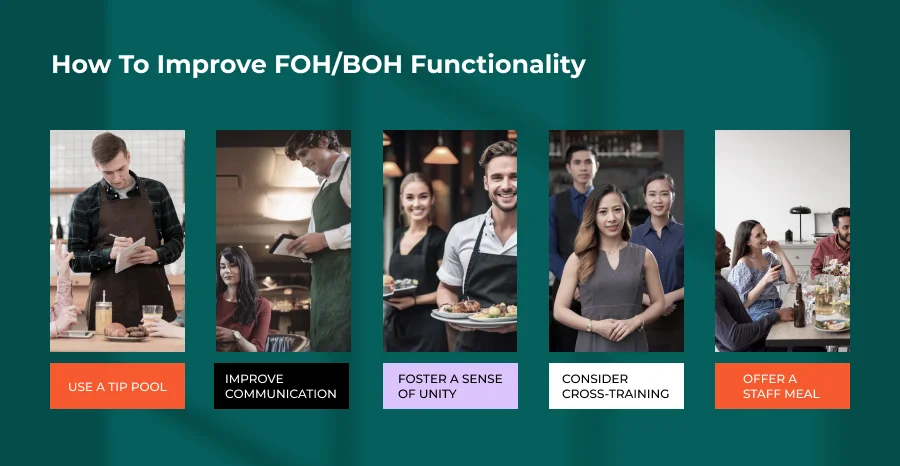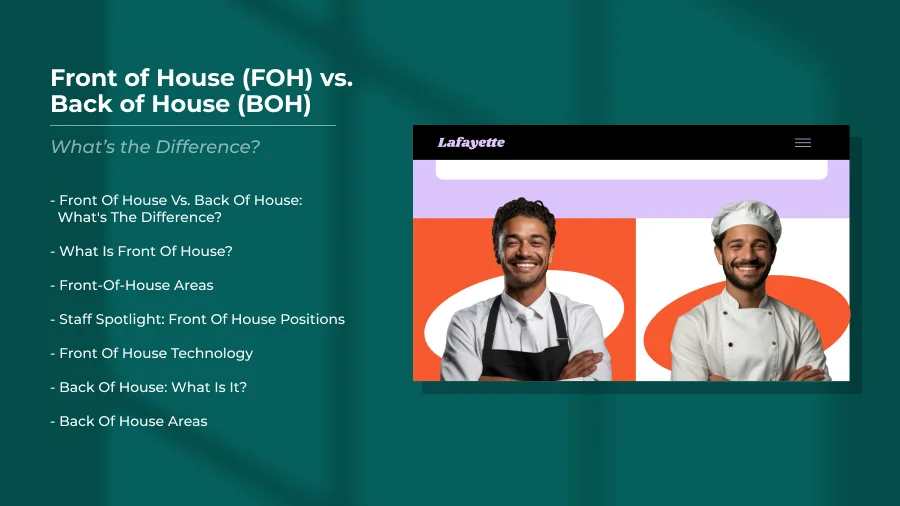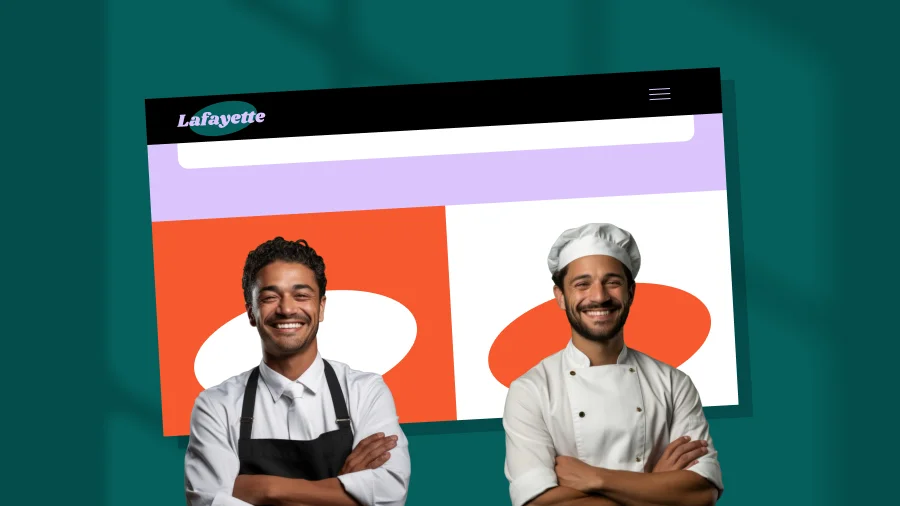Front of House (Foh) Vs. Back of House (Boh): What’s the Difference?
The distinction between a restaurant's front of house (FOH) and back of house (BOH) is that the front of house refers to staff members, areas, and functions that are visible to guests, whilst the back of house refers to staff, areas, and services that are usually invisible to customers. Though one is more customer-facing, both are essential in maintaining the smooth operations of a restaurant.
What Is Front of House?
So, what exactly is front of house and what happens there? Front of house (FOH) refers to all of the places in your restaurant that set the tone for the customer's experience. These areas are managed by your restaurant's front-of-house staff, who have the greatest interaction with your customers during their visit. As a result, all restaurant front-of-house workers have to work together to produce a positive, memorable experience for each customer who shows up.
Front-of-House Areas
As mentioned, the FOH, or front of house, refers to the area's most visible to guests. Front of house areas in a restaurant can include:
Entryway
As visitors walk in, they are first exposed to the ambiance and general vibe of your restaurant. It is where they will be met by the host at the stand, so make a good first impression.
Waiting Area
This is where customers can wait in comfort while their table is being prepared.
Bar Area
The bar is a terrific spot to interact with guests. It's also an artful way to upsell your guests on a drink before they dine.
Dining Room
Dining RooThis is an important touch point in the dining experience because this is where customers will most likely interact with your front of house staff, especially your servers.
Restrooms
Most guests will use your restaurant's restrooms during their visit, so keep this area clean, tidy, and well-stocked.
Patio Seating
An outdoor dining area is always welcomed by guests, especially during the summer. The more visually appealing it is, the better!
Staff Spotlight: Front of House Positions
FOH staff have close contact with guests and the kitchen, and they inevitably do a variety of tasks.

General Manager
The GM oversees all aspects of the restaurant's operations, including front and back of house. They spend most of their time in the dining room. This job is important to the restaurant's owner. There is no doubt that a good general manager can make all the difference. The restaurant owner relies on the general manager to be their eyes and ears, and ensure all operations run smoothly.
Front of House Manager
This role reports to the General Manager and oversees all front-of-house workers. They interview and hire new employees, create timetables, and manage client concerns.
Headwaiter
he headwaiter directs the wait staff, host staff, and bussers to provide the finest customer service possible. A good headwaiter has a positive outlook and an optimistic mindset. Most crucially, they supervise in addition to serving their own tables.
Bartender
The bartender is the person your customers trust to offer them the ideal drink for any occasion. They pour beer and wine, create cocktails, and serve soft drinks. Before the shift, they must also serve food and prepare bar garnishes such as lemon and lime slices.
Server
Servers are your people. Because servers have the most direct contact with guests, they should be friendly and accommodating. A good server knows the menu, can answer questions, take orders, make suggestions, and connect with the kitchen crew. Hence, a good server must also be professional and courteous.
Food Runner
Nobody enjoys having their food served cold. Provide a valuable service and ensure that food is served swiftly and hot. Interact with the guests. Know what's on the menu and be prepared to meet any special requests, such as extra ranch, cutlery, napkins or drink refills.
Bar-Back
A bartender's assistant.
Busser
These employees set up tables for guests and clean up dirty dishes. Bussers should wear clean clothes, wear aprons, and maintain a professional attitude because they spend most of their time in the dining area.
Front of House Technology
Front-of-house technology is essential for all of the workers listed above to carry out their duties. Tech can assist your front-of-house team in running operations more efficiently and improving the overall customer experience. Your staff will also be able to minimize wait times and avoid errors with your guests' orders.
Here are some of the most essential parts of FOH technology:
Point-of-Sale (POS) System
A POS system is the heart of your restaurant's operation. This system enables restaurateurs to optimize their operations and manage orders, payments, and menus more efficiently.
Payment Systems
In addition to the POS, payment hardware and software offer your guests a variety of options to pay for their meals. Ideally, it would be best if you used a payment processing solution that is integrated with your POS so that your staff does not have to enter transactions into payment terminals manually. It not only speeds up payment processing but also reduces errors.
Self-Order Kiosks
Short-staffed? No issue! Self-order kiosks allow guests to order and pay on their own. This type of self-service technology helps to keep lines flowing and wait times short. It also lets the guests browse your menu, order, and pay for their menu and drinks at their leisure, which some guests may prefer.

Back of House: What Is It?
The BOH is where the magic happens, even though it is less visible to guests.
So, what does BOH stand for? Back of house (BOH) refers to all of the people and areas that operate behind the scenes in your restaurant. It is key because the functionality, staff, technology, and spaces that make up the back of house ensure that your restaurant operates as efficiently as possible.
Back of House Areas
Kitchen
The kitchen is the heart of any restaurant because it is where orders are prepared, cooked, and plated. But that's not all! The kitchen is also where all of the ingredients for a restaurant are stored, as well as where the dirty dishes are washed.
Administrative Areas
Administrative work is done at the back office. Keeping operations running smoothly behind-the-scenes.
Backroom for staff
Most restaurants have a backroom where staff can take breaks. This is an excellent example of how back of house areas are not always visible to guests but are available to employees and staff members.
Back of House Positions
Kitchen Manager
The kitchen manager is in charge of supervising the back of house workers. Their responsibilities include ensuring that safety standards are met, employing fresh hires, and regulating chaos by helping when needed.
Executive Chef/Head Chef
The executive chef is the kitchen's most senior member. They plan menus and specials, order food, calculate expenses, and perform administrative tasks.
Sous Chef
Sous Chef reports to the executive chef. They supervise the kitchen crew, train employees, and set the schedule. If the head chef is absent, the sous chef takes over.
Line Cooks
Line cooks are stationed in the kitchen and are classified based on the type of food cooked or position in the kitchen. Examples are fry cooks and salad cooks.
Expeditor
The expeditor oversees organizing orders. They are often well-versed in the menu items.
Dishwasher
Dishwashers oversee washing and drying dishes and glassware.
Back of House Technology
Back of house technology is essential for your BOH team to accomplish their duties. So, what does this imply for your BOH, and how can it help? You can turn over orders faster, streamline communication between kitchen staff, and maximize profitability with the proper back of house solutions.
Here are some of the most essential components of back-of-house technology:
Kitchen Display System
A kitchen display system is a screen that displays order tickets from the POS system. A kitchen display system for your BOH workers can assist in streamlining communication, reduce the time it takes to create an order and reduce errors in day-to-day operations.
Back Office Software
Though not as flashy as a great KDS, restaurant back office software is critical in helping management streamline back office activities like inventory management, shipping and receiving, and profit maximization.
Front of House and Back of House: How Do They Are Connected?
Technology is important in connecting the front and back of the house in the restaurant industry. Many restaurant technologies are available to help streamline communication and keep everyone on the same page.
Some common restaurant technology that connects the front and back of house include:
- Table Management System
- Restaurant Reservations
- POS System
- Restaurant Accounting Software
- Restaurant Inventory Management
- Kitchen Display System (KDS)
- Order Management System

FAQs on FOH vs. BOH
1) Which is more difficult: BOH or FOH?
It all depends on the work and the individual experience. Both jobs require a separate set of talents and have their own set of problems. Back of House (BOH) positions are generally more physically demanding because they need a lot of time touching stock and making sure there is adequate stock for the business to run efficiently. A Front of House (FOH) position, on the other hand, is more customer-service-focused and requires greater interaction with consumers.
2) What is the difference between FOH and BOH?
FOH staff are liable for providing the greatest possible customer experience and a friendly shopping environment. While BOH staff oversee any non-customer-facing activity.
